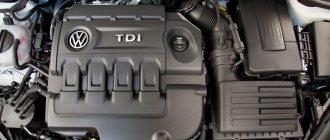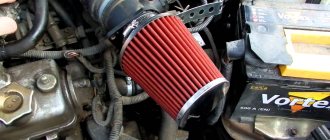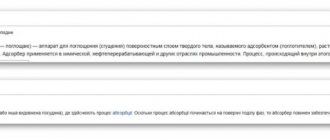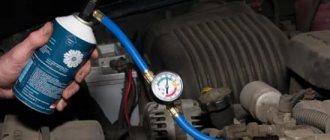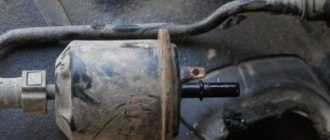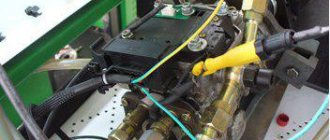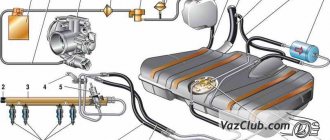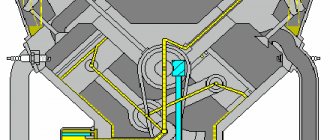The fuel supply system in the Kia Rio-3 has two filters : coarse filter (mesh filter - a mesh bag) and fine filter (plastic block with a filter element inside). Both filters are components of the fuel module located in the fuel tank.
According to the Kia Rio-3 maintenance regulations, the fuel filter is replaced every 60 thousand km.
Signs indicating the need to replace the fuel filter:
- Insufficient pressure in the engine fuel system (the norm is a pressure of at least 345 kPa or 3.45 kgf/cm2).
- Unstable engine idling
- Loss of engine power
- Reduced engine response during acceleration.
- Jerks and failures in engine operation.
All of the above may be a consequence of a decrease in the throughput of the fuel filter (both fuel filters). At the same time, replacing fuel filter elements may be necessary ahead of schedule . It all depends on the quality of the fuel poured into the gas tank.
Signs of filter failure
The only way a filter can break is by getting clogged. The blockage prevents the normal passage of gasoline. Symptoms of blockage are:
- the car refuses to start (or starts with difficulty);
- the engine runs jerkily;
- the car accelerates worse than before;
- unstable operation at idle;
- noise during pump operation;
- decrease in pressure in the fuel line (norm - 345 kPa).
If any of the above are observed, the problem is most likely a clogged filter. It's worth replacing.
Popular brands:
Kia Rio
The filter becomes clogged gradually, making it difficult for the car owner to determine the initial stage of contamination, but at the final stage the engine simply will not start.
How to select a new component?
Authorized Kia dealers recommend using only original filters. If you are the owner of a Rio 3, then the OE number of the main filter element is 311121R000.
The element looks like this:
In addition to original spare parts, you can use analogues from well-known manufacturers.
Typically, car owners believe that a fine filter should be under the hood. But this is not the case with Rio 3. The part is located in the fuel tank (as well as coarse cleaning). On the fuel pump in the tank there is also a mesh (original number - 31090-1G000), which is a coarse filter. If you wish, you can change it too.
Mobis spare parts for Kia and Hyundai cars are better suited than others. This company is a supplier to the assembly line of this automaker.
Choosing fuel filters for Kia Rio 3. Which one is better, part numbers and prices
The manufacturer insists that we use only original fuel filters. They have the following catalog numbers, fine filter:
- fine filter Hyundai/Kia 311121R000, price about 400-450 hryvnia;
- a non-original NIPPARTS filter with catalog number N1330330 costs 320 hryvnia;
- filter ASHIKA, Italy, article 300KK21, price 434 hryvnia, very good quality;
- English BLUE PRINT, article ADG02404, costs 480 hryvnia;
- Korean brand NSP, catalog number NSP02311121R000, price 220 hryvnia.
Coarse filter, mesh:
- original Hyundai/Kia filter 311841R000 costs 170-200 hryvnia;
- Korean filter KROSS, KM7901114, price 70 hryvnia;
- MOBIS, number 311841R000, in fact, this is a conveyor filter, but in the company’s packaging it costs no less than 270 hryvnia.
Replacing the Kia Rio fuel filter: how to do it?
First, prepare the tools and materials you will need:
- heads for 8 and 12 with extension;
- flat and figured screwdrivers;
- pliers;
- knife;
- sealant.
Let's take a step-by-step look at how to replace the Kia Rio 3 fuel filter. It is better to work in a lit garage. No pit or lift is needed.
- Using a 12mm socket with an extension, unscrew the bolt holding the rear seat cover.
- The seat itself is also held in place by latches. Let's take it off.
- Under the seat there is a plastic hatch that covers the fuel pump. It is held in place by sealant, which must be removed with a knife or flat-head screwdriver.
- You will see the fuel supply module cover, it is attached with self-tapping screws. Hoses and wiring harness fit to it.
- To relieve pressure, you need to turn off the chip and let the car run without it.
When the engine has used up all the fuel in the system and stalls, crank it 2-3 more times with the starter. That's it, the pressure has been released. Use pliers to compress the supply hose clamp and disconnect it.
The second hose is attached to “quick connectors”. Squeeze its chip and gently pull it off.
Wipe the fuel module cover from dust so that when dismantling, debris does not get into the tank. Using a 8mm socket or Phillips screwdriver, unscrew the screws holding it in place.
Remove the clamping ring, then carefully remove the fuel cell. It is advisable to keep a rag at hand - gasoline may spill.
Do not touch the float of the fuel level sensor to the edges of the tank, otherwise there is a high probability of damage to it.
Next you need to remove the rubber o-ring. Now be sure to unplug the sensor connectors and release the guides to remove the cover. It is better to do this with a flat-head screwdriver.
We dismantle the sensor.
Carefully remove all fuel pipe clamps. Remove the outlet fitting tube tip, then remove the rubber O-ring. We do the same with the inlet fitting.
There are guide clamps on the cup body. They need to be pryed off with a flathead screwdriver to release the guide rods.
Separate the glass from the lid. Then unfasten the shoe. Now you can remove the filter element from the housing along with the pump, as well as the coarse filter.
Using a flat screwdriver, press out the 2 latches and remove the pump itself.
The coarse filter is held in place by a lock washer. You need to remove it with a flat screwdriver. Now this mesh needs to be removed.
There is a rubber O-ring at the tip of the drain tube that needs to be removed. Then disconnect the ground wire.
Using a flat screwdriver, press out the 2 lugs of the latch and remove it. Then remove the fuel pressure regulator that was holding the clamp. Remove the fuel drain pipe.
Using a flathead screwdriver, remove the rubber seal you see in the photo. You will still have a fine filter in your hands.
Replace it with a new one. Then reassemble everything in reverse order.
Signs of a worn fuel filter
It is irrational to disassemble the Kia Rio 3 fuel filter just to check its condition, so most experienced drivers can already tell by some behavioral features that something is wrong with the car. Symptoms of a faulty filter include:
- noticeable drop in power;
- increased fuel consumption regardless of driving style;
- the engine does not hold idle speed or stalls completely, failures in the operation of the unit are felt;
- twitching appears at high speeds;
- the car reacts late or very sluggishly to pressing the accelerator pedal;
- deterioration in dynamics.
The mixture produces too much air and not enough fuel. This adversely affects the life of the engine, especially valves and cylinders. Naturally, these signs may indicate another problem, but the fuel filter itself should always be included among the “suspects”.
To be more precise, a small check of the pressure in the fuel system will help you. If it is not large enough, then with almost 100 percent probability we can talk about a problem with the fuel filter. Each driver can do the check independently. You will need a small hose, a tee and a pressure gauge with a measurement limit of 5 kgf/cm2. Once you have all this prepared, follow these steps:
- First of all, of course, make sure there are no leaks. Inspect the fuel lines for leaks. To do this, it will be most convenient to put the car on a lift or use a pit.
- Check the contacts on the fuel system devices; if they are coated, clean them.
- Turn on the ignition and listen, the fuel pump should be activated, but only if the engine has not been running 1-2 hours before. If the engine has been started recently, the pump will be silent. This is a normal phenomenon; the unit maintains the required pressure for a short period of time after stopping the engine.
- The next step is to release the pressure. To do this, find the block with the relay in the engine compartment and stick it out in the left corner.
- A tee and a pressure gauge must be connected between the inlet fitting of the ramp and the fuel line.
- Start the engine and look at the pressure gauge. If it is less than 3.45 kgf/cm2, then the pressure is too low and, most likely, it is due to a clogged filter, although a pump malfunction should not be discounted.
After the measurement, do not forget to remove the pressure gauge and return the relay to its place. As you can see, this is a simple and quick diagnostic method that can be carried out even in a garage.
If you don't change, what will happen?
If you do not change the component in time, you will heavily load the pump, which will find it difficult to push fuel through the system, because the fuel pump screen is already clogged. The car will begin to pick up speed worse, its power will decrease, and the original dynamics will disappear. Sometimes you will observe power dips when the internal combustion engine is running. This is especially noticeable when driving uphill.
The engine will start worse day by day - until the moment when it fails altogether. And this happens sometimes.
Problems with the filter will increase fuel consumption. For example, if previously a car consumed 9–10 liters per 100 km, then with a clogged filter this figure can increase to 11–12 liters. Dips will appear when you press the accelerator pedal. This can lead to an accident when overtaking on a country highway when you need to accelerate sharply.
At that moment, when you are standing at a traffic light, the engine speed in idle mode can fluctuate - right up to the point where the internal combustion engine stalls. You will remain standing at the crossroads - there is little pleasure in this.
The process of replacing a part on the Rio model is presented in this video:
Replacing the filter at a service station
To avoid taking on this Kia Rio maintenance work, you can turn to the experts. Pros will quickly deal with this problem. Work and an original filter for Kia Rio 2012 from the manufacturer will cost about 1.5 thousand rubles.
If your Kia Rio 2012 is under warranty, then you cannot qualify for a free filter replacement, due to the fact that these car parts are parts that are especially susceptible to natural wear and tear, along with lamps, brake pads and discs, fuses, etc.
You should keep documentation of any Kia Rio repairs, maintenance, or record it in your service record. You need to at least keep your own records of exactly when and what was done, taking into account the mileage of the Kia Rio at the same time.
Experienced car enthusiasts who are familiar with the Kia Rio 2012 look at the 5-year warranty with great skepticism. Particularly because there is a long list of exceptions. And they advise you to cancel the warranty after one year of operation of the Kia Rio 2012.
Take timely and regular care of your Kia Rio 2012 - and it will delight you with excellent trouble-free operation, economical fuel consumption, smooth ride, and comfort while driving.
https://youtube.com/watch?v=dWG336ZSqcU
How often to change the fuel filter on a Kia Rio?
When answering any question related to vehicle maintenance, you should first refer to the technical documentation. It is she who will keep the rules that must be followed unconditionally.
But more often than not, the realities of Russian roads make their own adjustments, and consumables have to be changed more frequently. This also happens in the case of the fuel filter. The maintenance schedule assumes that the fuel cell must be replaced every 60 thousand kilometers.
At the same time, if you rely on the opinion of technical experts, filter clogging may manifest itself earlier.
It is expressed in:
- reduction in engine power;
- difficulty starting the car engine;
- failure when pressing the gas pedal;
- increasing the level of unpleasant odor in the cabin;
- increasing noise level.
All these signs indicate that the part is clogged, which means that the part should be replaced before the deadlines specified in the regulations.
How to replace this consumable yourself
If you have an idea and will do it yourself to replace the fuel filter, this will allow you to save on service costs. In this article we will tell you how to change the filter, as well as where it is located, but before you start, you will need to purchase a new consumable, for this you only need to know its catalog number.
To successfully implement the process you will need to use the following tool:
- screwdrivers with slotted and Phillips profiles;
- keys and pliers.
The operation cannot take much time, and the presence of boxing is not at all a necessary condition.
Filter selection
When performing repairs and replacing the filter device, you must select the correct part for installation.
When purchasing, you should be guided by the catalog numbers of fuel purifiers:
- the device for fine cleaning has article number 31112-1G000;
- fuel coarse cleaning element - number 31090-1G000;
- rubberized sealing ring for the pumping device - 31118-3J300;
- sealing rubber directly for the filter - 31115-1 G000.
If you can’t buy original parts for Kia, you can opt for analogues.
This is interesting: What is the best oil to pour into the engine of a Kia Sportage
What is the point of regular replacement?
None of the car enthusiasts will allow themselves to doubt the modernity, practicality and beauty of the Kia Rio 3 model, as well as the Kia Rio 2 version from the Korean manufacturer KIA. To ensure uninterrupted operation of the power system, the fuel filter element should be replaced in a timely manner. The regulatory period for such action is:
- every 2 years;
- after 60 thousand km and so on.
The “consumables” we are considering need to check their condition every 30 thousand km.
The purpose of the filter for Kia Rio 2 and other versions of the model is that it prevents dirt and other impurities found in the fuel from entering the ramp and injectors. Sources of waste include the following:
- substandard fuel, although a high-quality product inevitably contains up to 0.1% of all kinds of impurities;
- the presence of rust on the bottom and walls of the tank in Kia Rio 2 of different generations, as well as in the fuel line.
Timely replacement of the filter will save the owner of a Kia Rio 3 from the failure of an expensive power system pump.
Which filter to choose
When choosing a part, it is necessary to take into account the type of internal combustion engine. Officially, KIA Rio 3 with diesel power units was not supplied to the Russian market. There are only a few such machines in Russia. Finding an original fuel filter for such cars is very difficult. It is best to purchase an analogue from Bosch.
There is no point in buying cheap Chinese filtration systems. Their prices are lower, but the quality of the filters themselves leaves much to be desired. They purify diesel fuel worse. The risk of power plant failure increases.
It is easier to purchase a filtration system for KIA RIO 3 with a gasoline engine. The volume of the power plant does not affect the selection of parts. Engines with a volume of 1.4 and 1.6 liters use the same filtration system. Moreover, a similar unit is used on KIA Sportage, Sorento and some Hyundai cars (Accent and Elantra).
It is best to search for an original filter in stores by its article number - 31112-1R000. Analogues from AMD, Finwhale and Nipparts are also suitable. Factory part numbers for these parts are AMD.FF45, PF731 and N1330330, respectively.
Replacing the fuel filter on KIA Rio 2015, 2016 and earlier years of production is best combined with installing a new filter mesh. It is used as a preliminary filtration system and prevents massive foreign particles contained in gasoline from entering the filter. Mesh article number – 31184-1R000. As an alternative, it is better to use a mesh from the Cross company with article number KM79-01114.



